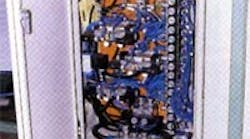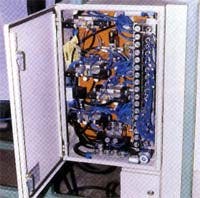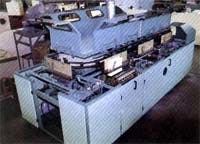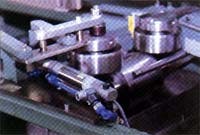Most people read magazines a few times and then throw them away. Therefore, publishers bind their magazines to last through such limited usage. On the other hand, libraries and businesses must save magazines so the information in them will be available to dozens or even hundreds of readers over long time periods. How can they keep these periodicals from falling apart after that kind of service?
One answer is rebinding — used extensively in the U.S. and now generating interest in Europe — a series of procedures that supplements and strengthens the original binding of magazines and other publications for permanent storage with frequent retrieval. Often involving manual procedures and crude mechanical tooling, the slow pace of rebinding once limited its use. Now, however, new adhesive technology is combining with economical pneumatic actuation and the control flexibility of microprocessor-based programmable logic controllers in automated rebinding machines that can increase productivity by 500%.
The Ultrabind machine, built by Mekatronics, Port Washington, N.Y., exploits the double-fan adhesive binding technique to simplify and dramatically shorten the traditional 41-step rebinding process. In this technique, the spine edge of the book is fanned to expose both sides of each page and glue is applied during this exposure. While perhaps not as strong as sewn volumes, double-fan adhesive-bound volumes show minimum margin infringement, excellent openability, and durability.
The in-line multistation Ultrabind machine can process at random a wide range of publication sizes and is selfadjusting and easy to maintain and service. It accomplishes ten operations within eight interconnected stations:
Loading. Magazines or sheets of paper are stacked in blocks, loaded manually with spine down into an empty spring-loaded clamp, and slid against the clamp’s left side. A sensor signals the PLC to close a lower clamp, freeing the operator’s hands to insert the endpapers. After a short delay, a warning buzzer sounds, the main clamp closes, and the block moves to the next station.
Milling. A milling cutter removes the spines from the block, exposing paper fibers for linkage with the adhesive.
Spine notching. Spine preparation plays a key role by providing more area for adhesion. The spine-notching unit consists of an adjustable multiple-blade cutter. Air cylinders actuate additional clamps to hold the book block firmly in place during notching. A Festo DGO magnetically actuated, rodless air cylinder drives the notching cutter fitted to its yoke. This arrangement requires only half the space that would be needed for a conventional cylinder.
Sanding. As the block hangs freely from a clamp at its open edge, a highspeed sanding drum runs against the spine of the book, deflecting the pages and sanding the spine edge and adjacent sides to remove some of the paper coating and improve glue adhesion. Next, the clamp opens slightly to let the endpapers drop flush with the spine.
Brushing. A brush cleans off dust and chips from milling and sanding.
Double-fan gluing. In manual operations, the most critical aspect of fan gluing is the need to apply uniform pressure on the block when it is being deflected in either direction to induce fanning of the pages. The Ultrabind machine solves this problem in a unique manner whereby the rotating glue roller first presses against the book block, then is articulated to move in a curvilinear path against the spine of the stationary block. This produces a pageby- page fanning and tipping action to assure penetration of adhesive between pages. On the return stroke, glue is applied to the opposite face of the pages.
Notch filling. An extra layer of glue is applied at this station to fill the notches in the spine. Sensors detect the front and rear edges of the block prior to the application of glue.
Squeezing. To improve the quality of rebinding, book thickness is gauged and side rollers are pressed pneumatically against the pages to remove any swelling induced by the double-fan gluing. This also holds the pages tight together, preventing glue in the notches from penetrating between the pages.
Lining. This procedure begins to install the protective material that will cover the glued spine. Backlining material is fed in, matched to the leading edge of the book, and coated with a thin film of glue. As the book passes, a softrubber pneumatic roller presses the lining onto the book. Simultaneously, the roller forms backlining flaps on each side of the spine prior to folding the lining against the book. When the trailing edge of the book is detected, the material strip is automatically cut off with a fast-response, pneumatically actuated knife.
Flap-folding. Backlining material is folded against the sides of the book in an innovative operation which pulls the backlining flaps over the sides without wrinkles to yield smooth, square, quality- bound volumes.
Unloading. At this final station, a pneumatic cylinder opens the clamp and the glued book drops a short distance onto a pneumatically powered platform. This platform gently lowers the book onto a curved chute for delivery to a conveyor belt or other pick-up mechanism below. For safety, a photoelectric sensor stops the operation if a book fails to leave the clamp.
Design engineer Ken Lines of Mekatronics and applications engineer Tarek El-Sawaf of Festo Corp., Hauppauge, N.Y., described this equipment.




